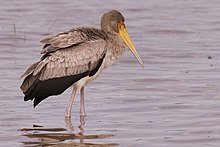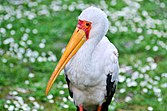Yellow-billed stork
| Yellow-billed stork | |
|---|---|

| |

| |
| A breeding adult in South Africa and a juvenile bird in Tanzania | |
| Scientific classification | |
| Domain: | Eukaryota |
| Kingdom: | Animalia |
| Phylum: | Chordata |
| Class: | Aves |
| Order: | Ciconiiformes |
| Family: | Ciconiidae |
| Genus: | Mycteria |
| Species: | M. ibis
|
| Binomial name | |
| Mycteria ibis (Linnaeus, 1766)
| |
| Synonyms | |
|
Tantalus ibis Linnaeus, 1766 | |
The yellow-billed stork (Mycteria ibis), sometimes also called the wood stork or wood
Taxonomy and evolution
The yellow-billed stork is closely related to three other species in the genus Mycteria: the
Before it was established that the yellow-billed stork was closely related to the American wood stork, the former was assigned to the genus Ibis, together with the milky stork and painted stork.[4] However, the yellow-billed stork has actually long been recognised as a true stork[5][6] and along with the other 3 related stork species, it should not strictly be called an ibis.[4]
Description



This medium-sized stork stands 90–105 cm (35–41 in) tall.
These storks walk with a high-stepped stalking
This species is generally non-vocal, but will utter hissing
Distribution and habitat

The yellow-billed stork occurs primarily in Eastern Africa,
The species does not generally
Preferred habitats include
This species breeds especially in
Behaviour and ecology
Food and feeding
This stork's diet mainly comprises small, freshwater
This species appears to rely principally on sense of touch to detect and capture
In addition to the snap-bill reflex, the yellow-billed stork also uses a systematic foot stirring technique to sound out evasive prey.
The yellow-billed stork has been observed to follow moving
Parents feed their young by regurgitating fish onto the nest floor, whereupon it is picked up and consumed by the
Breeding behaviour
Breeding is seasonal and appears to be stimulated by the peak of long heavy rainfall
The yellow-billed stork may also begin nesting and breeding at the end of long rains. This occurs especially on flat extensive marshlands as water levels gradually decrease and concentrate fish sufficiently for the storks to feed on.[4] However, unseasonal rainfall has also been reported to induce off-season breeding in northern Botswana[19] and western and eastern Kenya. Rainfall may cause local flooding and hence ideal feeding conditions.[4] This stork appears to breed simply when rainfall and local flooding are optimal and hence seems to be flexible in its temporal breeding pattern, which varies with rainfall pattern throughout the African continent.[4]
As with all stork species, male yellow-billed storks select and occupy potential nest sites in trees, whereupon females attempt to approach the males.
Reciprocally, approaching females display their own distinct behaviours. One such behaviour is the Balancing Posture,[3] whereby she walks with a horizontal body axis and extended wings toward the male occupying the nesting-site. Later, when the female continues to approach or already stands near an established male, she may also engage in Gaping. Here, the bill is gaped open slightly with the neck inclined upward at about 45°[3] and often occurs in conjunction with the Balancing Posture. This behaviour ordinarily continues if the male accepts the female and has allowed her to enter the nest, but the female usually closes her wings by this time.[3] The male may also continue his Display Preening when standing next to the female in the nest[3]
During copulation, the male steps onto the female's back from the side, hooks his feet over her shoulders, holds out his wings for balance and finally bends his legs to lower himself for
The female typically lays 2-4
Both parents share duties of guarding and feeding the young until the latter are about 21 days old.[4] Thereafter, both parents forage to attend to the young's intense food demands.[4] Alongside parental feeding by regurgitation of fish, parents have also been observed to regurgitate water into the open bills of their nestlings,[24] especially on hot days. This may aid the typical thermoregulatory strategy of the young (common to all stork species)[3] to excrete dilute urine down their legs in response to hot weather.[3] Water regurgitated over the young serves as a water supplement in addition to fluid in their food, so that they have sufficient water to continue urinating down their legs to avoid hyperventilation.[3] Additionally, parents sometimes help keep the young cool by shading them with their open wings.[4]
The nestlings usually fledge after 50–55 days of hatching[3] and fly away from the nest. However, after leaving the nest for the first time, the offspring often return there to be fed by their parents and roost with them for another 1–3 weeks.[3] It is also thought that individuals are not fully adult until 3 years old[4] and despite lack of data, new adults are thought to not breed until much later than this.[4]
Nesting


The yellow-billed ibis is a colonial nester, often alongside other species;[21] but the yellow-billed stork is sometimes the only occupant species of a nesting site.[4] Colonies are usually 10-20 nests in size, with several males occupying potential nest sites all in the same place.[4] If many of these males do not acquire mates, the whole group moves on with the unpaired females to another tree. These “bachelor parties”[3] are a noticeable feature of colonies of this species and usually consist of 12 or more males and at least as many females.[3] As many as 50 nests have been counted all at once in a single breeding area.[10]
The male and female together build the nest of sticks either in high trees on dry land away from predators, or in small trees over water.[25][4] Nest building takes up to 10 days.[4] The nest may be 80–100 cm (31–39 in) in diameter and 20–30 cm (7.9–11.8 in) thick.[4]
Other behaviours
Despite their
Hostility can also arise between opposite sexes when a female approaches a male on a potential nest site. Both sexes may display a similar aforementioned Forward Threat, but clatter their bills after grabbing with them at the other stork and extend their wings to maintain balance.[3] Another hostile behaviour between sexes is the Snap Display,[3] whereby they snap horizontally with their bills while standing upright. This may occur during and immediately after pair formation, but subsides later in the breeding cycle as the male and female become familiar with each other and it eventually disappears.[3]
Threats and survival
As well as being abundant and widespread, the yellow-billed stork also appears tolerant of short-term natural habitat changes.
Alongside human activities, natural enemies include
In culture or relationships to humans
The yellow-billed stork has appeared on postage stamps in several African countries.[29]
Status
This species is evaluated as
Gallery
-
Immature atMaasai Mara National Reserve
-
Storks sometimes rest on their hocks (analogous to a human's heels)
-
Juveniles have grey backs, mature birds have white backs
-
Fishing in shallow water
-
Juvenile
-
Flock at Lake Nakuru National Park, Kenya
-
Weltvogelpark Walsrode, Germany
-
With a Nile crocodile at Kazinga Channel, Uganda
-
Chobe National Park, Botswana
-
On the bank of a river
References
- . Retrieved 19 November 2021.
- ^ Peters
- ^ a b c d e f g h i j k l m n o p q r s t u v w x y z aa ab ac ad ae af ag ah ai aj ak al am an ao ap aq ar as at au av aw ax ay Kahl, Ibis
- ^ a b c d e f g h i j k l m n o p q r s t u v w x y z aa ab ac ad ae af ag ah ai aj ak al am an ao ap aq ar as at au av aw ax ay Hancock, et al.
- ^ Garrod, On the form...
- ^ Garrod, On the disposition...
- ^ Sinclair, et al.
- ^ a b c d e Kasoma and Pomeroy
- ^ Rand
- ^ a b Bannerman
- ^ Clancey
- ^ Fraser
- ^ Langrand
- ^ Bell-Cross
- ^ Kahl and Peacock
- ^ Pooley
- ^ a b c d e Kahl, Journal of East African Natural History Society and National Museum
- ^ Brown and Britton
- ^ Tree
- ^ "Yellow-Billed Stork".
- ^ a b c Brown, et al.
- ^ Schüz
- ^ Kahl, Ecological Monographs
- ^ Stronach
- ^ Andrew, Elliott; Garcia, Ernest; Boesman, Peter F. D. (March 4, 2020). "Yellow-billed Stork Mycteria ibis". Birds of the World (1.0 ed.). Retrieved 16 August 2023.
- ^ "Yellow-billed stork videos, photos and facts - Mycteria ibis | ARKive". Archived from the original on 2015-04-02. Retrieved 2015-03-15.
- ^ "Yellow-billed Stork - DesertUSA".
- ^ a b c d Parsons
- ^ "Yellow-billed Stork stamps". Archived from the original on October 19, 2000.
{{cite web}}: CS1 maint: unfit URL (link) - ^ a b c d "Yellow-billed Stork (Mycteria ibis) - BirdLife species factsheet". www.birdlife.org. Archived from the original on 2012-09-24.
Sources
- Bannerman, D.A. (1953). The birds of west and equatorial Africa, Vol. 1. Oliver & Boyd: London.
- Bell-Cross, G. (1974). "Observations on fish-eating birds in central Africa". Honeyguide, 77: 23–31.
- Brown, L.H., and Britton, P.L. (1980). The Breeding Seasons of East African Birds. East African Natural History Society: London.
- Brown, L.H., Urban, E.K., and Newman, K. (1982). The Birds of Africa, Vol. 1. Academic Press: London.
- Clancey, P.A. (1964). The Birds of Natal and Zuzuland. Oliver & Boyd: London.
- Fraser, W. (1971). "Breeding herons and storks in Botswana". Ostrich, 42: 123–127.
- Garrod, A.H. (1875a). On the form of trachea in certain species of storks and spoonbills. Proceedings of the Zoological Society of London, 1875: 297–301.
- Garrod, A.H. (1875b). On the disposition of the deep planar tendons in different birds. Proceedings of the Zoological Society of London, 1875: 339–348.
- James, Peter L. (1931). Checklist of the Birds of the World, Vol 1. Harvard University Press: Cambridge, USA.
- Kahl, M.P. (1972). "Comparative ethology of the Ciconiidae: The wood storks (Genera Mycteria and Ibis)". Ibis, 114: 15-29
- Kahl, M.P. (1964). "Food Ecology of the Wood stork (Mycteria americana) in Florida". Ecological Monographs, 34: 97-117.
- Kahl, M.P. (1968). "Recent breeding records of storks in Eastern Africa". Journal of East African Natural History Society and National Museum, 27: 67–72.
- Kahl, M.P., and Peacock, L.J. (1963). "The bill-snap reflex: a feeding mechanism in the American woodstork". Nature, 199: 505–506.
- Hancock, J.A., Kushlan, J.A., and Kahl, M.P. (1992). Storks, Ibises and Spoonbills of the World. Academic Press: London.
- Kasoma, P.M.B., and Pomeroy, D.E. (1987). "The status and ecology of storks and the shoebill in East Africa". Colonial Waterbirds, 10: 221–228.
- Langrand, O. (1990). Guide to the birds of Madagascar. Yale University Press: New Haven.
- Parsons, J. (1977). "The effect of predation by fish eagles on the breeding success of various Ciconiiformes nesting near Kisumu, Kenya". Journal of Natural History, 11: 337–353.
- Pooley, A.C. (1967). "Bird/crocodile and bird/hippopotamus commensalism in Zuzuland". Ostrich, 38: 11–12.
- Rand, A.L. (1936). The distribution and habits of Madagascar birds. Bulletin of the American Museum of Natural History, 72: 143–499.
- Schüz, E. (1957). "Das Verschlingen eigener Junger ( “Kronismus”) bei Vogeln und seine Bedeutung". Vogelwarte, 19: 1-15.
- Sinclair, I., Hockey, P.A.R., and Arlott, N. (2007). The larger illustrated Guide to the Birds of Southern Africa. Struik Publishers: Cape Town.
- Stronach, B.W.H. (1968). "The Chagana heronry in western Tanzania". Ibis, 110: 344–348.
- Tree, A.J. (1978). "A visit to Makgadikgadi Pan in April 1974". Honeyguide, 109: 18–19.
External links
- Yellow-billed Stork - Species text in The Atlas of Southern African Birds.











